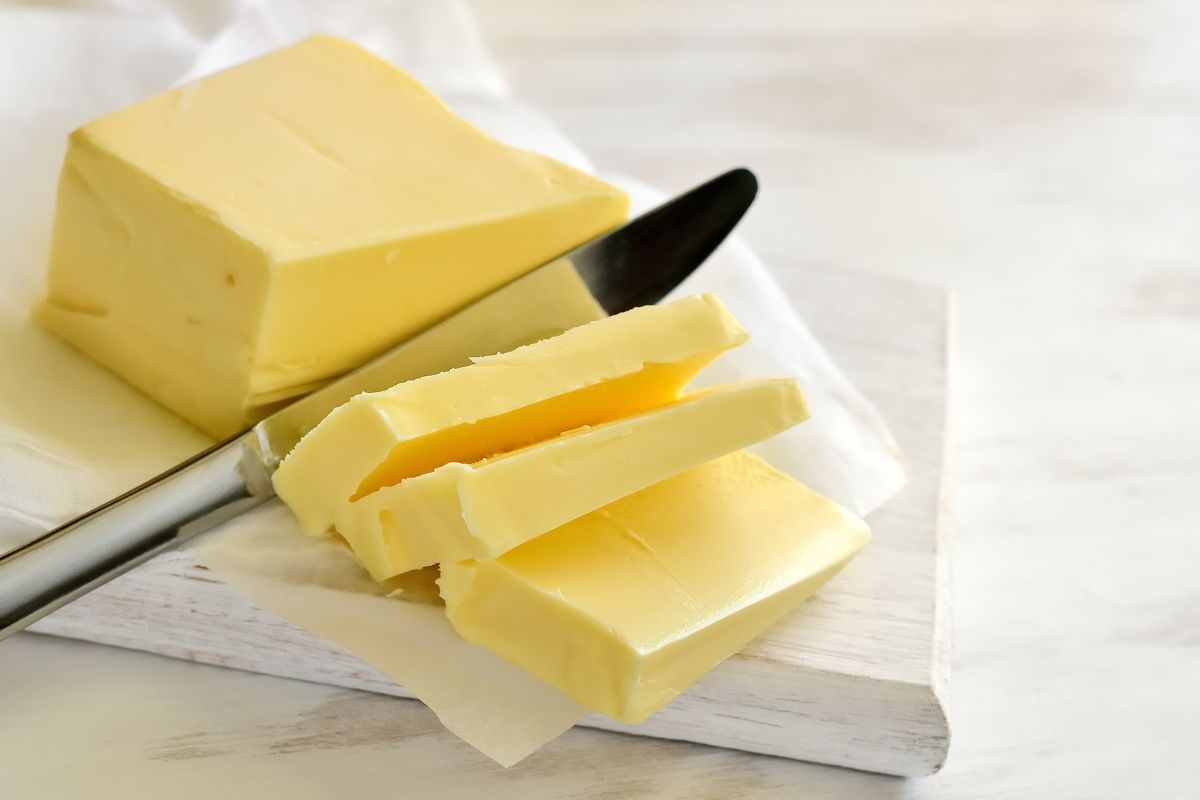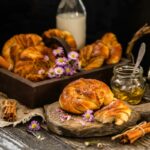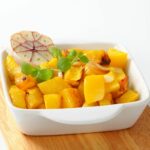Some recipes call for butter to be cut into the flour. This may seem confusing, and you may not know how to cut butter into flour.

But we are going to explain this baking essential so that next time you come across this instruction in a recipe you will be able to cut butter in like a pro.
What Does Cutting In Butter Mean?
The instruction to cut butter into flour means exactly that, to cut the butter up into small pieces making sure that each piece is coated in the flour and any other dry ingredients in the mixture.
Butter contains around 18% water and when this water turns to steam in a hot oven it acts as a leavening agent in your baked goods.
By using pieces of butter in various recipes the amount of steam is increased in pockets across the dough.
So for example, a scone dough would need butter pieces that are smaller than dough for flaky pie dough.
The larger pieces create larger pockets of steam in the pastry dough and create tender, flaky layers in your pie crust.
Tools For Cutting In Butter
Before we get on to how to cut butter into flour you will need to know which tools you can use for the job.
There are four or five ways to do this, so you have a choice depending on your recipe and what kitchen tools you have available.
Pastry Blender
A pastry blender or cutter is an ideal tool which has been specifically designed to cut butter into flour.
This utensil is a U-shaped implement with four or five blades attached to a straight handle. It allows you to accurately cut the butter in by targeting the larger pieces of butter.
Fork
You can use a fork to cut butter into flour, although this may make the pieces smaller than a pastry cutter.
This is ideal for cutting butter into scone dough as this consistency should be the same as coarse cornmeal.
Two Knives
This is probably the method used by your grandmother before the days of pastry blenders and food mixers.
Using a knife in each hand, cross cut the butter until you have the size of pieces that you need for your recipe.
Food Mixer
You can use a food mixer with the paddle attachment on slow to cut butter into flour.
This is quicker than manually cutting it in but doesn’t allow the same amount of control.
Fingertips
As a last resort you can use your fingertips to cut butter into flour but not the palms of your hands which are warmer than your fingertips.
How To Cut Butter Into Flour
Start by using chilled butter, cut into cubes. Put it into a bowl with your flour and other dry ingredients and toss to cover the butter pieces.
Using a pastry blender cut the butter into pea sized pieces for flaky pie dough or smaller for scone dough.
Scone dough should have the consistency of coarse cornmeal.
If the butter pieces are too large the butter will melt out of the dough and the scones will be sitting in butter.
Also you won’t get the leavening action as the butter has melted before the steam has formed to produce a little bit of leavening.
The larger pieces of butter in flaky pie dough will provide the pockets of steam necessary to separate the layers.
Temperature Of The Butter
The key to successfully cutting butter into flour is the temperature of the butter. It must be chilled or frozen.
This makes it easier to cut in but more importantly allows the butter to form pockets in the dough for leavening purposes.
Chilled butter will not melt as quickly and so allows the butter to be cut into the dry ingredients, creating the consistency and texture that you want.
Tips For Cutting In Butter

Carefully read the recipe to check what size the butter should be and the final texture that you should achieve.
Make sure the butter is well chilled before cutting in. Frozen butter works well in this respect as it will not warm up as quickly.
If you don’t have a pastry blender or food mixer using a fork or two knives to cut in butter can be tiring.
By using a cheese grater and frozen butter you can have large enough sized pieces of butter to add to your flour. Use the largest holes on the grater for best results.
Tools Not To Use For Cutting In Butter
A hand or stand mixer is not recommended for cutting in butter as neither are really capable of cutting the butter to appropriate sizes without completely incorporating it into the dry ingredients.
As the butter in your dough needs to be in pieces for the best leavening effect using your hands should be a last resort for cutting in butter.
The warmth of your hands, even your fingertips, which are the coolest part, may melt the butter and cause your pastry to be less than flaky.
Recipes That Require Butter To Be Cut In
Some of the most common recipes that require butter to be cut in are flaky pastry, scones and biscuits.
Flaky pastry requires the butter to be cut into the flour in pea sized pieces so that there are chunks of raw butter dispersed throughout the dough.
Scones will need finer pieces of butter something like the texture of coarse cornmeal so that the butter is evenly distributed through the scone dough to lift them.
Biscuit dough will benefit from butter that is cut in at ½ inch pieces to create a light and flaky texture.
In Conclusion
Cutting butter into flour is not that difficult as long as you start with chilled or frozen butter and use the most appropriate tool at your disposal.
The end result will be worth the effort. We hope you have enjoyed our guide on how to cut butter into flour.
- How To Reheat A Cheesesteak - November 5, 2023
- What Are Three Must Have Kitchen Knives? - September 22, 2023
- How To Protect Edges Of Pie Crust - June 15, 2023








